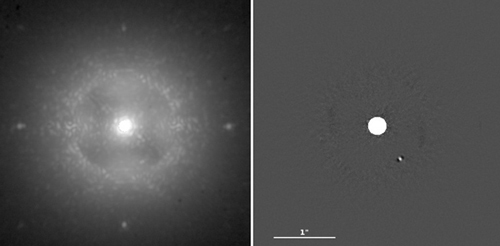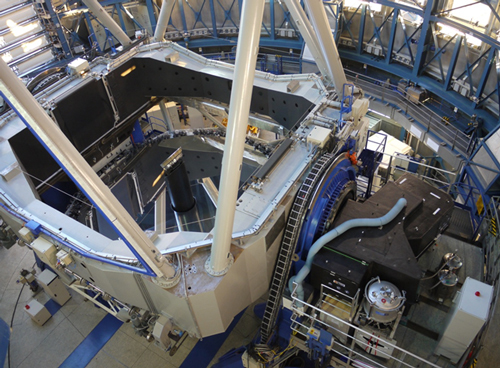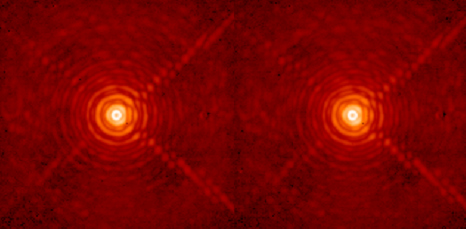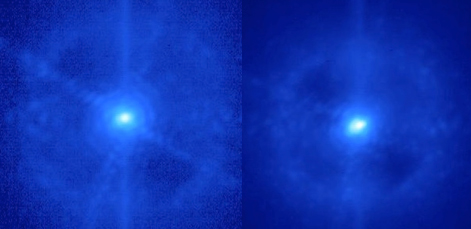The new European instrument SPHERE, installed on ESO’s Very Large Telescope in Chile, has just delivered the first images, which are of unprecedented accuracy. The core of the system: revolutionary adaptive optics developed by Onera, one of the world leaders in the field
The adaptive optics module SAXO (SPHERE AO for exoplanet observation) at the core of the SPHERE instrument was specially designed for the direct observation of exoplanets. The function of this module is to correct the defects introduced by atmospheric turbulence, by the telescope itself, or by the optical components of the scientific detection modules, with unmatched accuracy. This correction is achieved by nanometrically deforming a mirror (around a millionth of a millimetre), more than 1200 times per second.

Photo credits: ESO/SPHERE consortium
First image detected with the SPHERE instrument.
After masking the light from the star (at the centre) and processing, the companion - a white dwarf - is clearly visible, with a contrast of magnitude 10.7. On the left: raw image (SPHERE); on the right, the image after processing.
Using extreme adaptive optics, SPHERE has made it possible to achieve spatial resolutions that are unprecedented to date with a monolithic telescope on the ground, and has paved the way for major astronomical discoveries. As an analogy, the flame of a candle located 50 cm away from a lighthouse located in Marseille could be observed from Paris. This thus places SPHERE at the forefront of astronomy research, with a performance range comparable to that which would be available on a space observatory (beyond the Earth's atmosphere).
Beyond this scientific and technological prowess, Onera has also significantly contributed to the development of image processing techniques that are built into the instrument. Based on over 15 years of expertise in the field, the algorithms developed by Onera’s researchers will enable the images obtained by SPHERE to be further improved and make it possible to fully utilize every photon detected.
Developments in adaptive optics, which were initially motivated by astronomical needs, are now used in many fields: medical imaging, ophthalmic surgery, high-power lasers, high speed optical telecommunications, surveillance and threat identification, etc.
Voir aussi :

Photo crédits : Julien Girard / Jean-Luc Beuzit
SPHERE (on the right) attached to Melipal, the third 8m telescope of the VLT
Saxo, the adaptive optics system within SPHERE, uses a deformable mirror with 1377 actuators (over a diameter of around 20 cm) and tip-tilt mirrors to finely stabilize the optical axis (with accuracy greater than 2 milliarcseconds, that is, a displacement of 1 cm viewed from a distance of 1000 km).
The sensors that enable the deformations to be measured quickly and with very high sensitivity are state of the art worldwide in the field (240x240 pixels at over 1300Hz, with almost zero read noise). Beyond its outstanding performance, one of the essential characteristics of Saxo is its ability to self-optimise and self-calibrate, and thus to be used by non-experts.

Photo credits: ESO/SPHERE consortium
First corrected H-band images (infrared wavelength 1.6 µm).
In these 2 images taken at 20 minute intervals, one can observe:
- the correction quality: at the diffraction limit, in the presence of turbulence, the gain provided by adaptive optics in terms of resolution is greater than 20
- stability over time: a key ingredient for image processing, guaranteeing a final instrument performance exceeding the original specifications

Photo credits: ESO/SPHERE consortium
Images taken at wavelengths of 0.85 and 0.65 microns. Despite these short imaging wavelengths, the Airy disks can be distinguished, indicating the best possible image of the point observed by the system. The angular resolution of this data (around 25 milliarcseconds) is the best ever achieved at the VLT.

Photo credits : ESO/SPHERE consortium
- on the left: Titan as observed by SPHERE (H-band)
- in the centre: SPHERE image improved by the Mistral algorithm developed at Onera – this is the best image of Titan ever obtained from the ground
- on the right, synthetic image reconstructed from the data obtained by the Cassini probe (see http://space.jpl.nasa.gov/)




